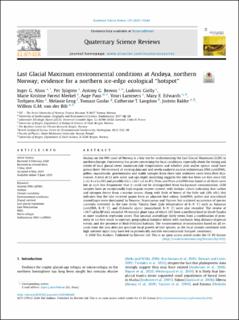| dc.contributor.author | Alsos, Inger Greve | |
| dc.contributor.author | Sjøgren, Per Johan E | |
| dc.contributor.author | Brown, Antony | |
| dc.contributor.author | Gielly, Ludovic | |
| dc.contributor.author | Merkel, Marie Føreid | |
| dc.contributor.author | Paus, Aage | |
| dc.contributor.author | Lammers, Youri | |
| dc.contributor.author | Edwards, Mary E. | |
| dc.contributor.author | Alm, Torbjørn | |
| dc.contributor.author | Leng, Melanie | |
| dc.contributor.author | Goslar, Tomasz | |
| dc.contributor.author | Langdon, Cathrine | |
| dc.contributor.author | Bakke, Jostein | |
| dc.contributor.author | Van Der Bilt, Willem | |
| dc.date.accessioned | 2021-05-21T13:49:43Z | |
| dc.date.available | 2021-05-21T13:49:43Z | |
| dc.date.created | 2020-09-10T15:17:57Z | |
| dc.date.issued | 2020 | |
| dc.identifier.issn | 0277-3791 | |
| dc.identifier.uri | https://hdl.handle.net/11250/2756076 | |
| dc.description.abstract | Andøya on the NW coast of Norway is a key site for understanding the Last Glacial Maximum (LGM) in northern Europe. Controversy has arisen concerning the local conditions, especially about the timing and extent of local glacial cover, maximum July temperatures and whether pine and/or spruce could have grown there. We reviewed all existing data and add newly analysed ancient sedimentary DNA (sedaDNA), pollen, macrofossils, geochemistry and stable isotopes from three lake sediment cores from Øvre Æråsvatnet. A total of 23 new dates and age-depth modelling suggests the lake has been ice-free since GI2 (<23.4 cal ka BP) and possibly GS3 (<26.7 cal ka BP). Pinus and Picea sedaDNA was found in all three cores but at such low frequencies that it could not be distinguished from background contamination. LGM samples have an exceptionally high organic matter content, with isotopic values indicating that carbon and nitrogen derive from a marine source. Along with finds of bones of the little auk (Alle alle), this indicates that the lake received guano from an adjacent bird colony. SedaDNA, pollen and macrofossil assemblages were dominated by Poaceae, Brassicaceae and Papaver, but scattered occurrence of species currently restricted to the Low Arctic Tundra Zone (July temperature of 8–9 °C) such as Apiaceae (sedaDNA, 8–9 °C), and Alchemilla alpina (macrofossil, 8–9 °C) were also recorded. The review of >14.7 cal ka BP data recorded 94 vascular plant taxa, of which 38% have a northern limit in Shrub Tundra or more southern vegetation zones. This unusual assemblage likely stems from a combination of proximity to ice-free water in summer, geographical isolation linked with stochastic long-distance dispersal events, and the presence of bird-fertilized habitats. The environmental reconstruction based on all records from the area does not preclude local growth of tree species, as the local climate combined with high nutrient input may have led to periodically suitable environmental ‘hotspot’ conditions. | en_US |
| dc.language.iso | eng | en_US |
| dc.publisher | Elsevier | en_US |
| dc.rights | Navngivelse 4.0 Internasjonal | * |
| dc.rights.uri | http://creativecommons.org/licenses/by/4.0/deed.no | * |
| dc.title | Last Glacial Maximum environmental conditions at Andøya, northern Norway; evidence for a northern ice-edge ecological “hotspot” | en_US |
| dc.type | Journal article | en_US |
| dc.type | Peer reviewed | en_US |
| dc.description.version | publishedVersion | en_US |
| dc.rights.holder | Copyright 2020 The Authors. | en_US |
| dc.source.articlenumber | 106364 | en_US |
| cristin.ispublished | true | |
| cristin.fulltext | original | |
| cristin.qualitycode | 2 | |
| dc.identifier.doi | 10.1016/j.quascirev.2020.106364 | |
| dc.identifier.cristin | 1828814 | |
| dc.source.journal | Quaternary Science Reviews | en_US |
| dc.relation.project | Norges forskningsråd: 230617 | en_US |
| dc.relation.project | Norges forskningsråd: 250963 | en_US |
| dc.relation.project | EU/819192 | en_US |
| dc.identifier.citation | Quaternary Science Reviews. 2020, 239, 106364 | en_US |
| dc.source.volume | 239 | en_US |

